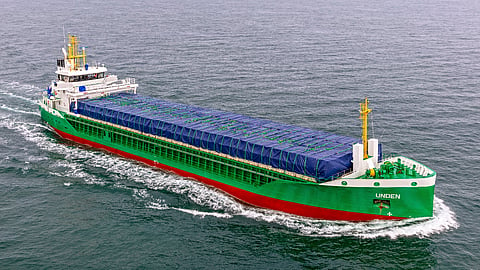VESSEL REVIEW | Unden – Ice-capable, large-capacity ship to support European wood trade
Dutch shipbuilder Royal Bodewes recently handed over a new general cargo vessel to Rörd Braren Bereederungs of Germany. Unden is a sister of Annika Braren, which was delivered to the same owner in 2020. The vessels are being used primarily for transporting wood in the Baltic, North, and Mediterranean Seas, even during winter.
The newbuild has an LOA of 86.93 metres (285.2 feet), a moulded beam of 15 metres (49 feet), a draught of 6.35 metres (20.8 feet), a gross tonnage of 2,999, and a cargo hold that measures 60 by 12.4 metres (200 by 40.7 feet) and has a capacity of 6,200 cubic metres (220,000 cubic feet). An ABC 8DZC 1,780kW (2,390hp) main engine drives a Berg nozzle-housed, controllable-pitch propeller via a Renk gearbox to deliver a speed of 12 knots even at full load. The propulsion arrangement also includes two 130kWe auxiliary engines, a 66kWe emergency generator, a 300kW bow thruster, and a steering system from Rolls-Royce.
“We had this ship built for our charterer Ahlmark Lines, which had also chartered Annika Braren,” Rörd Braren told Baird Maritime. “Their wish was to have two more vessels, so we ordered two sister ships from the same yard.”
“The ship has ice class 1A and the Clean Ship notation from BV,” added Royal Bodewes. “This means that none of the ship’s bunker tanks are connected to the hull shell plating.”
Retaining performance while expanding capacity
The builder remarked that the vessel is the latest example of a series of more than 17 units. The main challenge encountered during construction was in making sure all the necessary equipment and systems could fit without exceeding the maximum allowable limits on length, gross tonnage, and power consumption. Fortunately, it was still possible for the length to be extended to increase cargo capacity without any change in the engine selection, and the vessel’s fuel consumption figures even satisfied the owner’s requirements.
“The ship burns significantly less fuel compared to the older vessels in our fleet,” said Rörd Braren. “It generates fewer CO2 emissions in addition to helping the charterer reduce costs. This is made possible through the new efficient bow form, which allows for smoother sailings.”
The owner added that both size and tonnage are ideal. Specifically, having the gross tonnage below 3,000 means the vessel is able to comply with most restrictions being enforced in ports and channels.
A selective catalytic reduction system meanwhile reduces NOx emissions by as much as 90 per cent, and a shore connection allows the vessel to rely on local grids in ports instead of its own generators for electrical power. As an additional energy-saving measure, LED lighting is used all throughout the vessel.
Operation with reduced risk
Unlike most other vessels in the Rörd Braren fleet, Unden is not fitted with its own cargo cranes. The owner decided that fitting cargo cranes on the vessel would not be economical, as many of the ports to be visited have cranes available. The only deck equipment on board are a set of electric winches and a hydraulic gantry crane for opening and closing the 10 pontoon-type hatch covers fitted above the cargo hold.
“Our goal is always to keep ships as simple as possible,” Royal Bodewes told Baird Maritime. “That makes them easier to maintain as well as lessens the risk of failure.”
Unden is operated by a crew of nine. All are housed in single cabins with en suite sanitary facilities and individual air conditioning.


